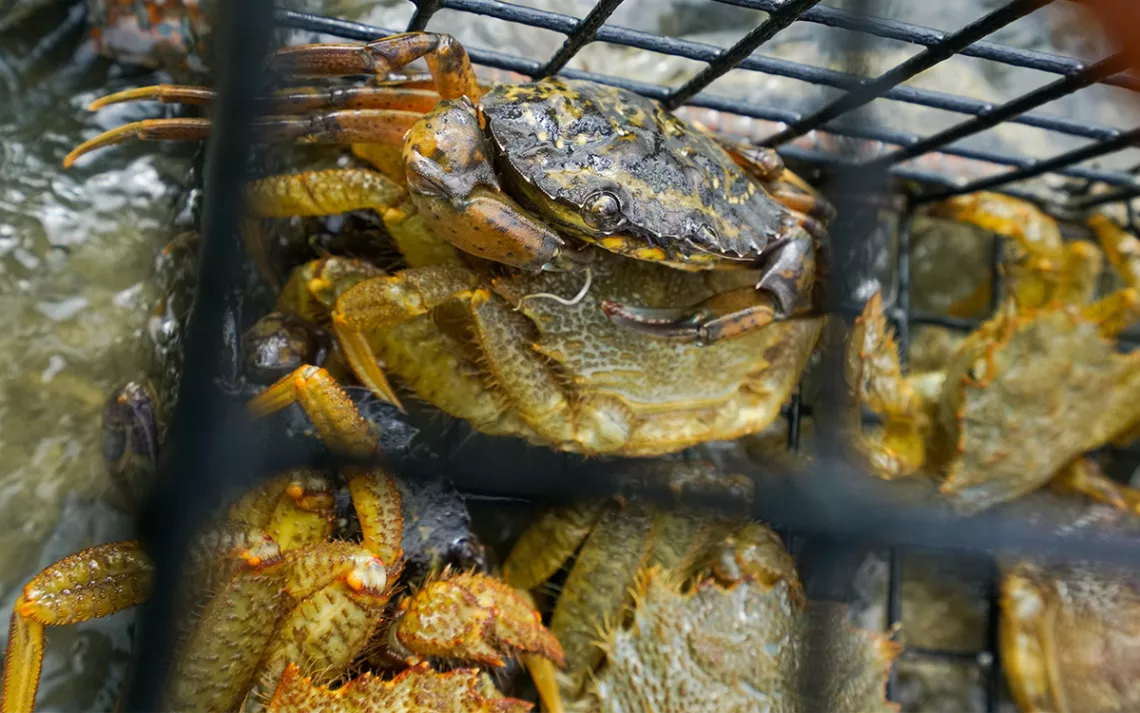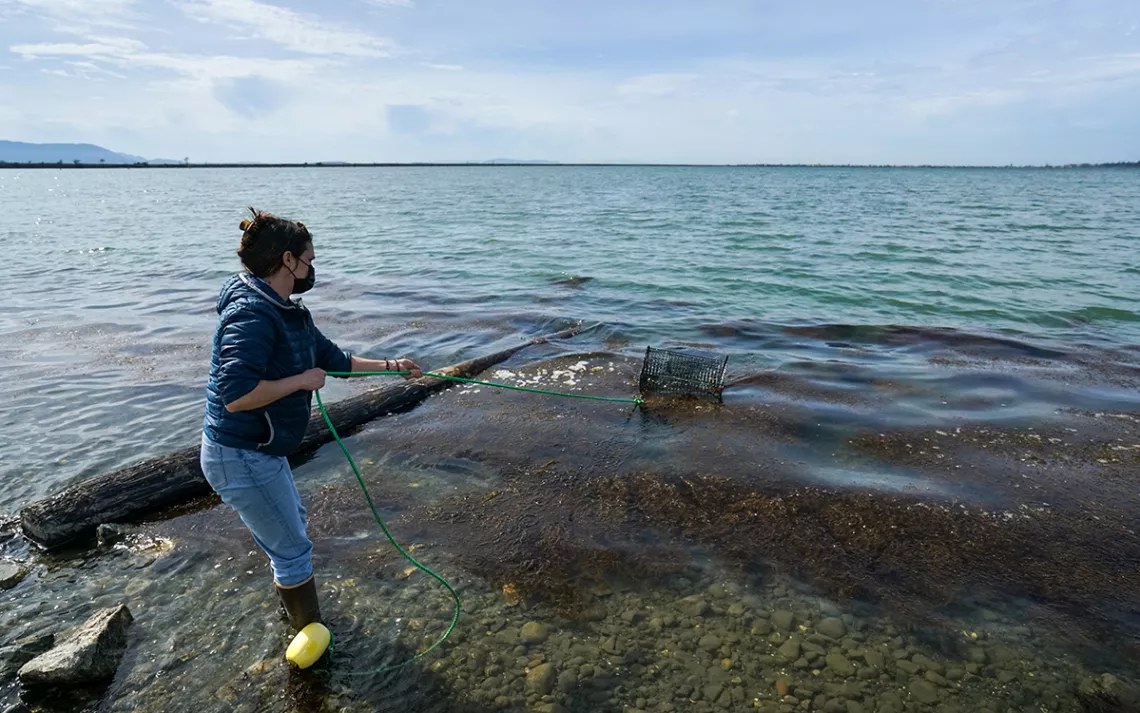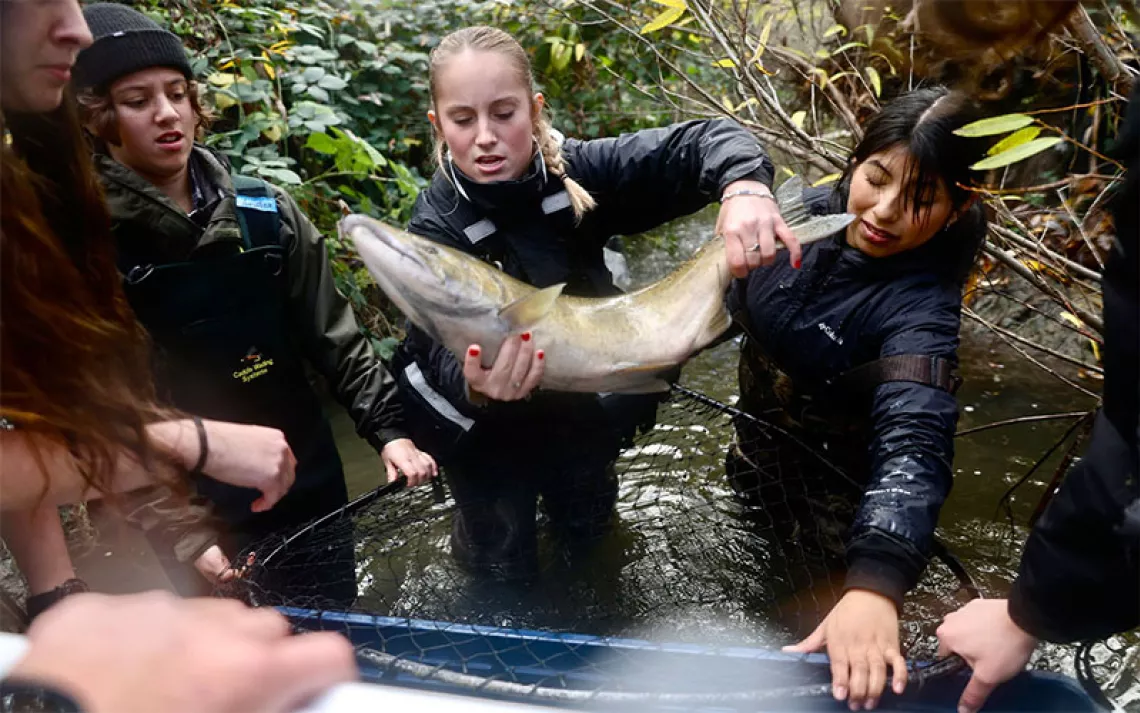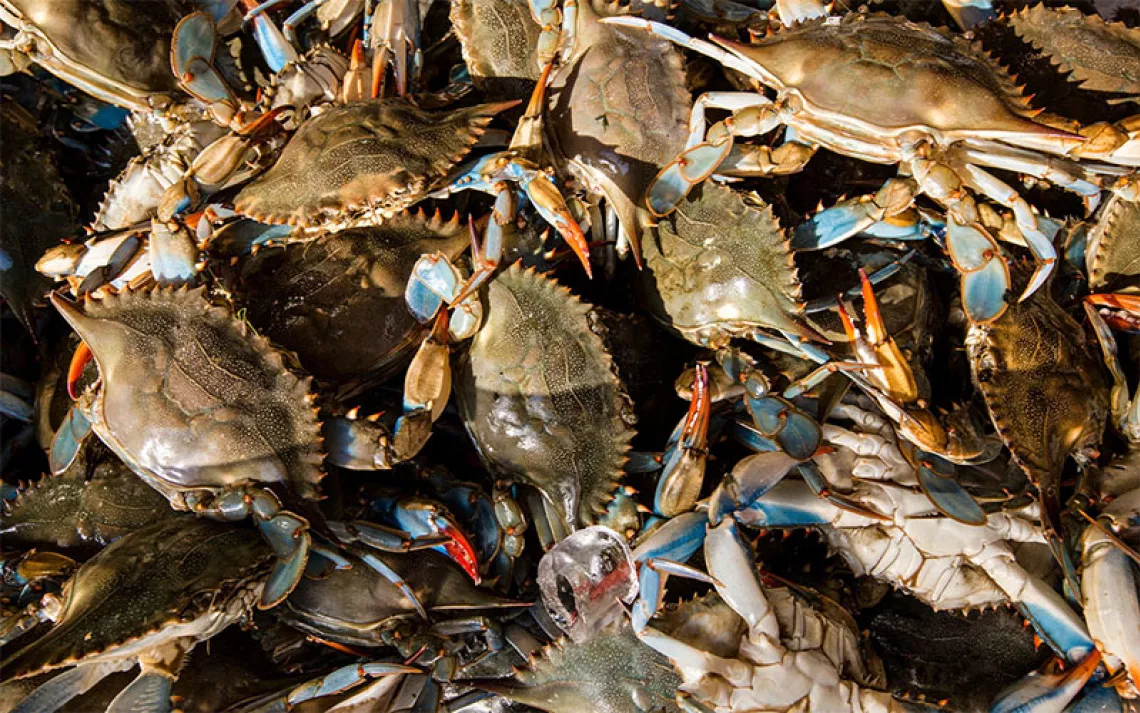European Green Crab Populations Are Exploding in Washington State
With a recent executive order, Governor Inslee tries to stem their spread before it’s too late

An invasive European green crab sits in a Lummi trap surrounded by native hairy helmet crab. | Photo by Michael Crowe
Emily Grason was returning from a walk with her dog in 2016 when she noticed the missed call on her phone. It was from a volunteer in the San Juan Islands, where Washington Sea Grant (WSG)—part of the federal network to promote healthy coastal environments and economies—had been setting traps for about a year. The caller was breathless: They had found European green crabs.
Then Grason, a marine ecologist and program manager for the WSG crab team, opened her email. The small crab stared back at her, caught in Westcott Bay on the north end of San Juan Island. She felt a flood of adrenaline. “Your mind starts racing to ‘What’s the next step?’” said Grason.
It was a troubling discovery. The National Oceanic and Atmospheric Administration (NOAA) calls green crab one of the most damaging marine invasive species around, or “one of the worst invasive species in the world,” according to Allen Pleus, aquatic invasive species unit manager for the Washington Department of Fish and Wildlife (WDFW). On the eastern coast of the United States and Canada, invasive green crabs are well established and have been creating problems for decades, depressing shellfish harvests (a single crab can eat 22 clams a day) and causing widespread damage to marine ecosystems.
These crab tear up native eelgrass, which provides important shelter for juvenile salmon heading out to sea. They can overpower and eat native shellfish, including young Dungeness crabs, which are one of the most valuable fisheries on the West Coast and a key part of the marine economy in several states. And their burrowing behavior in coastal estuaries leads to erosion of fragile salt marsh ecosystems. A much-discussed video shared by WSG from years ago shows gloved hands scooping dozens of the squirming creatures from inside an eroded bank reportedly on the East Coast.
“This is a species that has a reputation and a history of causing a lot of economic and ecological damage in places where it has been able to establish populations,” said Grason. “We don't know for sure that that’s exactly what’s going to happen here. But everything about the history of this species tells us that we are facing a formidable challenger.”
That fear of a widespread infestation has grown in recent years, sparking emergency declarations and millions of dollars in spending to slow their proliferation. Extensive damage from green crabs hasn’t been documented in Washington yet, said Grason, and they’d like to keep it that way.
“Obviously we don't know if and how much impact it can have to our state,” Pleus said. “But by the time you find out, it’s way too late.”
European green crabs have been expanding their reach on the west coast for decades, and have shown a remarkable ability to adapt to the conditions of the northeast Pacific with their fairly durable bodies and tolerance for wide swings in temperature. The species was first found in California waters in 1989 (likely after hitching a ride in the ballast water of a ship, according to NOAA) and traveled up the coast, establishing populations in Oregon, British Columbia, and the coastal waters of Washington by 1998. So while San Juan Island was not the first place green crabs were found in Washington, it was the first detection in the state’s inland waters.
In the years since 2016, WSG continued to expand its network of traps to monitor for the creatures. But the spread continued, and by fall 2021, officials realized the problem was growing, and potentially spiraling out of control.
The Lummi Sea Pond, a tribal aquaculture facility near Bellingham, Washington, that houses a shellfish hatchery and salmon-rearing habitat, is one of the areas of great concern. The three-square-kilometer bay is only about two meters at its deepest points and is enclosed on all sides by berms and gates. The protected, shallow waters make it the perfect habitat for green crabs, and they were thriving.
Forty-one crabs were captured in 2019, 2,670 in 2020, and a staggering 86,028 in 2021. Some of that is likely from increased trapping operations, but the belief is their numbers are growing too. The concern is that a large population could spread outside the bounds of the sea pond deeper into Puget Sound, seeding an uncontrollable infestation. The Lummi Nation declared a disaster on November 23, 2021. The Makah Tribe also declared an emergency, and the Shoalwater Bay Tribe followed suit at the start of 2022.
On January 19, 2022, Washington governor Jay Inslee signed an emergency declaration to address growing populations of European green crab, a rare step for invasive species. His order outlined the fears: If crabs permanently establish large, widespread populations, they could harm endangered species like salmon (and the struggling Southern Resident orcas that feed on them), cultural resources important to Indigenous peoples, and the many businesses that rely on the health of Puget Sound and the Salish Sea, like shellfish growers.
The main avenue for the emergency order to stem the tide is a flood of funding for extensive population-control efforts and further monitoring. The EO came with a request to lawmakers for $8.9 million, which was approved. About $4.5 million of that will go directly to the Lummi Nation, Makah Tribe, and other groups to pay for trapping and extermination efforts.
A little less than $4 million will stay with the Washington Department of Fish and Wildlife to fund more than a dozen new crab staff—biologists, technicians, a community outreach specialist—and a blitz of trapping efforts, including hundreds of pots to catch and kill as many crabs as possible this year. The EO also opens a formal incident management command system, much like in response to an earthquake or other natural disaster.
To that end, more than 176,000 crabs have been removed from Washington waters and killed as of early September, thanks to various trapping efforts.

Bobbie Buzzell, lead green crab biologist for the Lummi Nation, pulls a trap from the Lummi Sea Pond. | Photo courtesy of Michael Crowe
On a relatively warm day in April, Lummi Nation green crab biologist Bobbie Buzzell crunched along the rocky shore of the sea pond near Bellingham. Faded ropes and buoys marking crab pots disappeared into the water at regular intervals.
She pulled up a trap the size of a carry-on suitcase, the contents squirming with life. But just a few green crabs were inside; the rest were the often-mistaken native hairy helmet crabs. She extricated one of the green crabs, careful to avoid the claws as it clung to the shrimp trap. “They can be pretty feisty,” Buzzell said. “They’re very aggressive—that’s part of the reason why they’re so adaptable. And they can very easily outcompete other species of the same size.”
But this one won’t do any more of that. Buzzell retrieved a cloudy ziplock bag from her car, then tucked the crab inside for a trip to the freezer, where the cold would kill it as humanely as they believe possible. Green crabs are edible and fished in their native range, but not considered a hugely appealing meal, according to WDFW. Instead, some have been used for compost, said Buzzell, but the majority go to the landfill. She threw the trap back in the shallow water with a splash, leaving the rest for a later crew.
This was just a taste of the seasonal trapping happening at the Lummi Sea Pond to reduce the crab numbers. Roughly 700 traps were dispersed across the shallow water at the time, with another 500 in production. Two to three boats worked the area daily, with several additional craft soon to arrive from contracted Lummi fishers.
The meager haul that spring was also a symptom of the early season, before the crabs become more active in summer and fall as water temperatures warm. In September 2021, by contrast, crews were pulling 80 to 85 crabs per trap in the sea pond, totaling thousands a week. “Our highest count in a single trap was 140,” said Buzzell. “Which is just crazy. We just weren’t expecting it to increase so rapidly.”
That spike helped spur the emergency order. Though many resources were focused on the sea pond, the issue already extended beyond its borders, with infestations on the coast and limited detections in other areas of the Salish Sea. But WDFW officials said failure at the sea pond could lead to a “rapid loss of European green crab management control in the Salish Sea as a whole.”
It’s difficult to predict what lies ahead as this response evolves, but most every option is on the table, said Buzzell. At the sea pond, they mulled a chemical treatment to kill crab larvae, but decided against it because of environmental risks and potential impacts to native shellfish. So the focus on trapping continues, though they won’t know until at least next summer if it is meaningfully reducing numbers. Buzzell fears they already lost control of the population last year, but the work continues. “Really, we don’t know,” she said. “There’s so much uncertainty. That’s another scary part of this.”
Adding to those fears, spring brought troubling indicators of further spread. In May, WSG captured a green crab in Hood Canal near Seabeck. A handful more have been caught there since, marking the farthest south the crabs have been confirmed in the Salish Sea, more than 100 kilometers from the sea pond population. But it’s also a sign the system is working: Grason said WSG has been monitoring the site since 2016, and this reinforces the importance of widespread sentinel traps to detect new populations quickly. “It’s like a smoke detector: We always have it running, we always do it, and we check our batteries to make sure it’s working,” said Grason. “And if it goes off, then we kick into action, and we know there's a problem.”
The Seabeck crabs have been sent for genetic sequencing to determine their origin, though results aren’t back yet. In the meantime, volunteers continue checking these warning traps across the region. In July, Alaska had its first confirmed detection of European green crabs, on Annette Islands Reserve. NOAA holds that as further support for survey programs, praising the Metlakatla Indian Community’s early detection program for the discovery.
By Grason’s estimation, eradication is already impossible in Puget Sound and the larger Salish Sea. But she shares the state’s hope that this blitz of trapping in high-population areas can contain the spread and mitigate potential harm to aquatic flora and fauna. She believes the emergency order is helping speed those efforts. But as in any project of this scale, success is not guaranteed.
What is clear: While they’ve made strides in sustainable trapping capacity, that may not be enough to manage the problem. Collaboration is key, said Grason, to protecting the interconnected inland waters.
“We have to not only trap hard, but we also have to trap smart. So that means learning as much as we can and thinking strategically about green crab at the regional scale, not just what’s going on at any one site,” she said.
Still, the stakes feel high. She recalled the end of the trapping season in fall 2021. The days were getting cold and darker while crews were still pulling up full traps later than in years past. Usually the annual stopping point came naturally—as the days grew short, catch number would drop off. But, Grason recalled, this was different.
“It felt like there was a lot of unfinished business out there, like we wished we could still spend more time trapping, because there’s still more crabs to catch.”
 The Magazine of The Sierra Club
The Magazine of The Sierra Club



